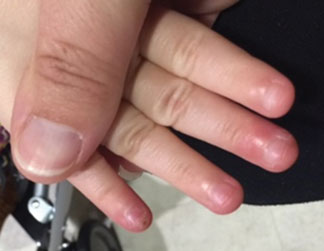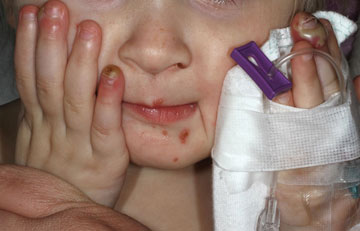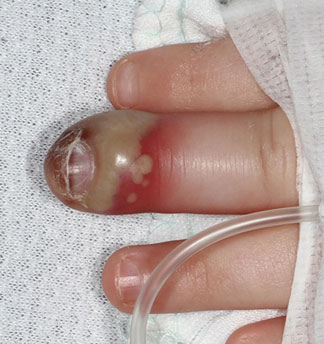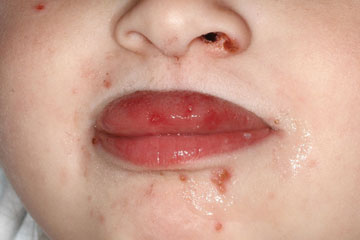3-year-old female presents with blistering lesions on fingers, oral sores
Click Here to Manage Email Alerts

Over the last 1 to 2 days, a 3-year-old female experienced a sudden onset of poor oral intake accompanied by blistering lesions on several of her fingers. By the next day, essentially all of the patient’s fingertips had become swollen and erythematous (Figure 1).

Source: James H. Brien, DO


The patient then presented to her primary care physician, who diagnosed her with multiple paronychia and prescribed Keflex (cephalexin, Pragma Pharmaceuticals) and topical mupirocin. According to the mother, the child could not tolerate the medicine because of pain in her mouth, and returned 2 days later with more finger pain and some sores in and about the mouth. She was given a shot of intramuscular ceftriaxone and a prescription for oral amoxicillin. However, the amoxicillin could not be tolerated — again because of mouth pain — and after outpatient management failed, she was admitted to the hospital.
The patient’s past medical history is that of a previously healthy 3-year-old child with some nervous habits that consist of trichotillomania and frequent nail-biting. Examination reveals normal vital signs and mild dehydration with some blistering lesions on several fingers of both hands, along with sores in and about her mouth and the left nostril (Figures 2 and 3).
What’s your diagnosis?
A. Multiple herpetic whitlows
B. Blistering distal dactylitis
C. Cellulitis of multiple fingers
D. Multiple bacterial paronychia
Case Discussion
This is a case of multiple herpetic whitlows, which resulted from primary herpes simplex stomatitis (Figure 4) with auto transfer of the virus to multiple fingers due to habitual nail-biting. It was easy to look back retrospectively at this point and realize that the reason the child could not tolerate the oral medicine was the pain associated with stomatitis. Of course, the antimicrobial agents prescribed would not have done any good anyway. However, if the diagnosis of herpes stomatitis had been made and the patient treated with acyclovir at the first visit, the progression may have been interrupted, potentially avoiding hospitalization. Vision is always 20/20 when viewed through the retrospectoscope.



In the hospital, the patient was treated with IV fluids for rehydration, as well as acyclovir. She also briefly received clindamycin for what was thought to be a mixed infection when first admitted with methicillin-susceptible Staphylococcus aureus, which grew from a surface culture of the largest lesion. However, it is unlikely that the Staphylococcus had anything to do with the development of this condition.
Multiple bacterial paronychia would be very unusual. Most of these infections are caused by S. aureus or Streptococcus pyogenes. However for some patients who are chronic nail-biters or work with their hands in water, gram-negative rods can also cause the infection (Figure 5). In addition, blistering distal dactylitis is a well-described but not a very common condition, and I’m unaware of any reports in which multiple fingers were involved. This curious condition is almost always caused by group A beta-hemolytic streptococci. Lastly, I featured a case of blistering distal dactylitis (Figure 6) in my column 28 years ago (June 1989), for those who may have kept that issue.
- For more information:
- James H. Brien, DO, is with the department of infectious diseases at McLane Children’s Hospital, Baylor Scott & White Health, Texas A&M College of Medicine in Temple, Texas. He also is a member of the Infectious Diseases in Children Editorial Board. Brien can be reached at: jhbrien@aol.com.
Disclosure: Brien reports no relevant financial disclosures.
